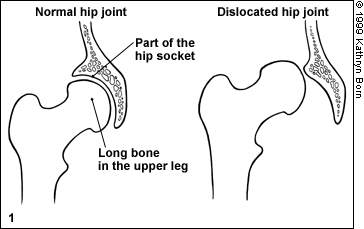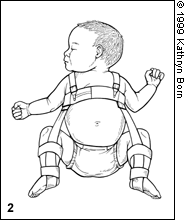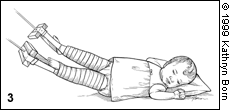
Am Fam Physician. 1999;60(1):187-188
See related article on developmental dysplasia of the hip.
Why does the doctor check my baby's hips?
A few babies have hip problems that can lead to dislocation of the hip bones. This means that the long bone in the upper leg comes out of the hip socket. If your baby has this problem, it's important to find out early so it can be fixed (see Picture 1).

A hip problem isn't always easy to see at first, so your doctor will check your baby's hips at each well-baby check-up until your baby can walk well.
How does the doctor check my baby's hips?
The doctor checks the hips of a newborn baby by gently pushing and pulling the thigh bones to see if they are loose in the hip socket. When your baby grows older, the doctor checks to see if your baby's thighs spread apart easily.
What if my doctor thinks my baby's hips might not be normal?
If your baby is a newborn and the problem isn't very serious, the doctor will probably check your baby's hips again in two weeks.
If the hip problem is more serious or if it's still there the next time your baby's hips are checked, the doctor may have you take your baby to a pediatric orthopedist. This is a doctor who has had special training in bone problems in children.
Sometimes a baby's hips may be checked by ultrasound. Ultrasound uses sound waves to take a picture of your baby's hips. X-rays of the hips can be taken when your baby is about three months old.
How are hip problems treated?
Most hip problems can be treated with a soft brace called a “Pavlik harness.” This brace keeps your baby's knees spread apart and bent up toward the chest (see Picture 2). If your baby is treated with this harness, the doctor will check your baby's hips every week or two at first, to see if the hip is going into place and staying there. Once the hip is in place, your baby will keep wearing the brace for another two or three months. Your baby wears the brace day and night for about three to six months.

About one in 20 babies needs more than a brace to fix a hip problem. Some babies need leg casts and traction (see Picture 3). Other babies need surgery to fix their hip problem.

You should tell your doctor if any relatives had hip problems when they were babies. Even if your baby's hips seem normal, the doctor may want your baby to have an ultrasound or an x-ray to be sure.